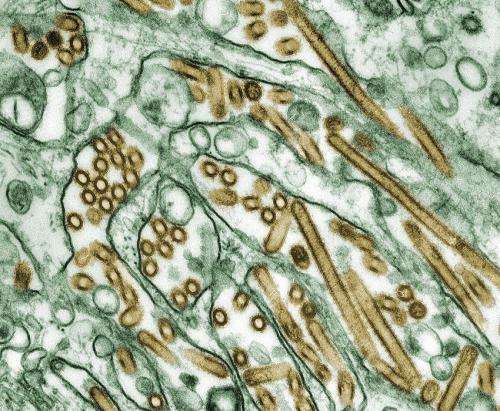This article has been reviewed according to Science X's editorial process and policies. Editors have highlighted the following attributes while ensuring the content's credibility:
fact-checked
reputable news agency
proofread
Goat dies of bird flu for first time in US, Minnesota officials say: Why it's 'significant'

Minnesota has reported the U.S.'s first ruminant—a group of animals including cattle, sheep, and goats—to test positive for avian influenza.
The finding is "significant" because "it highlights the possibility of the virus infecting other animals on farms with multiple species," State Veterinarian Dr. Brian Hoefs said in a March 20 news release from the Minnesota Board of Animal Health.
The animal to test positive was a goat kid, or juvenile goat, from a backyard farm in Stevens County, according to officials.
The farm had a flock of poultry that tested positive for Highly Pathogenic Avian Influenza (HPAI), specifically the H5N1 strain, in February.
Officials said they were alerted to unusual deaths among baby goats on the property in early March.
Before the poultry flock was quarantined and eventually culled due to the presence of the virus, the birds and goats shared a space and drank from the same water source, officials said.
One of the dead goats was brought for testing which revealed the presence of H5N1, according to officials.
"Samples from the adult goats were negative for HPAI and all appear healthy," the board said.
The Minnesota Board of Animal Health is working with the U.S. Department of Agriculture "to investigate the transmission of the virus in this case," officials said.
The virus has been found in just over 200 individual mammals including foxes, skunks, raccoons, harbor seals, and bears since 2022, but never in a ruminant species until now.
Stevens County is about a 160-mile drive northwest from Minneapolis and has only one reported outbreak since 2022.
National H5N1 outbreak
The current avian flu outbreak in the U.S.—caused by a variation of the H5N1 virus first detected in 1996—began in January 2022.
Genetic adaptations allow the new variable to spread easily among wild bird species, leading to an "uncontrollable global outbreak," according to researchers.
The spring migration of wild bird populations brings a higher risk of transmission to poultry birds, officials said.
To date, more than 82 million birds in the U.S. have been affected by the virus, according to the Centers for Disease Control and Prevention.
The mortality rate in poultry, specifically chickens, infected with the virus is 90% to 100%.
H5N1 in mammals
"Mammals appear to be dead-end hosts, which means they're unlikely to spread HPAI further," Hoefs said.
While data on mammals' susceptibility to the virus is limited, small-scale experiments on ruminant species offer encouraging insights.
In 2008, researchers in Germany inoculated four calves—another ruminant species –with the H5N1 virus to better understand their risk of transmission.
All four calves remained healthy and were able to develop their own antibodies to the virus.
H5N1 in humans
The risk to to humans remains "extremely low," according to the Minnesota Board of Animal Health.
"Any risk of infection is limited to people in direct contact with infected animals," the board said.
"To date, no people in the United States have become ill following contact with mammals infected with this virus," officials said.
In April 2022, the U.S. reported it's first and only case of H5N1 in a human, according to the CDC.
The individual was directly involved in culling a population of infected birds. The patient reported fatigue, but made a full recovery, the CDC said.
Over the last 20 years, 882 cases of H5N1 in humans from 23 countries have been reported, according to data from the World Health Organization. Of those 882, 461 were fatal resulting in a fatality rate of 52%.
To protect animals, officials recommend "cleaning equipment and housing regularly, separating livestock from wild animals, and calling your veterinarian when animals appear sick."
2024 The Charlotte Observer. Distributed by Tribune Content Agency, LLC.




















